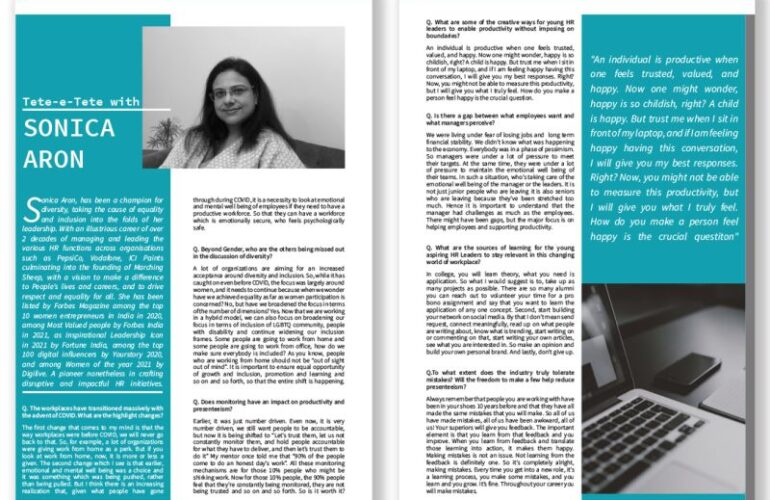Career Gap: Not a taboo anymore
Every person needs to take one day away. A day in which one consciously separates the past from the future. –Maya Angelou Having a gap in employment is a lot more common than you may think. And with the millennials comprising 80 % of the workforce today, it is actually becoming popular to take time out of work voluntarily. Here is an article on my take on “Career Gap- not a taboo anymore”. Please read and share your views in the comments section. Happy reading!
Every person needs to take one day away. A day in which one consciously separates the past from the future. –Maya Angelou
Achieving work life balance is one of the most frequently discussed topics in the corporate world today and especially the Millennials, who make up 35% of the global workforce today, are leading the way with this new mindset.
Some statistics
1. A recent report by ManpowerGroup shows that 84% of Millennials foresee significant career breaks along the way. This trend reinforces the idea that “career waves” are replacing the “career ladder” of earlier generations.
2. A study written by TSNE’s Deborah Linnell and CompassPoint’s Tim Wolfred, exposes the myth that an executive sabbatical will be a chaotic disruption, finding instead that the creative disruption of a well-planned sabbatical can be productive for the entire leadership of an organization. This study recommends funding sabbaticals as a best practice for leadership development, succession planning and organizational capacity building.
3. In the research conducted by The Sabbatical Project, 50 people were interviewed about their experiences of taking a sabbatical from work, and how it played a part in shaping their lives afterwards. Patterns in their responses show that separation from a stressful working environment, and the opportunity for rest and restoration, can provide a powerful ‘identity workspace’ to reflect and make lifestyle changes for the better.
4. According to the Huffington Post, Cliff Bar has a low employee turnover rate of less than 3%, and when the firm conducted a survey among its employees to determine which perks were the most useful to them, Sabbaticals came out on top.
5. A study by TSNE found that people who’ve took up the roles and responsibilities of employees on sabbatical leave have pursued them effectively.
How it benefits
Employment gaps exist between jobs. Career changes are evident. Parental leave is common. So why is there such taboo surrounding the topic of taking a “gap year”?
Gone were the days when for corporate employees their work life was everything.Today’s workforce prioritizes balance and yes they want to have a proper work life balance throughout their lives. Hence this trend of taking career gaps or work sabbatical is going to stay.
Also, since last 2 years there have been a lot of changes in the work culture across organizations as most of them have transitioned to remote working because of the pandemic. A lot of new leave policies are being introduced at the workplaces, but Sabbatical leave is still there and surprisingly being availed as well. Although the reasons for taking the Sabbatical leaves in the pre pandemic times were quite different like travelling, pursuing passions or hobbies, or opting for higher education.
A lot of work from home experts believe and state that they are suffering from Digital Fatigue and want to take a break just to spend time with their family and that’s how a new reason to take sabbatical leaves is coming into being.
In one of the recent articles in Times of India, Kelloggs South Asia director (HR) Nimisha Das said, “Despite the pandemic, it is unlikely that sabbaticals will go out of the vogue. Working professionals will continue taking them with the exception that the reasons for taking a sabbatical will change. For instance, one of the reasons earlier could be travelling. Now it might be to deal with the challenges of digital fatigue, pursue a newly acquired passion or to simply spend time with their families.”
Another reason which that has been the cause for career gaps nowadays is that when covid pandemic swept across the world in 2019 it caused millions to lose their jobs and made it difficult for them to get employment in the next two years.
There are several misconceptions around sabbaticals, one of them being that for an organization it will be a productivity loss to give an employee so many leaves. As a matter of fact, it actually benefits companies in many ways.
Let’s understand few benefits for both the parties:
For employee:
Ø Employees return rejuvenated and feel like working for challenging opportunities with renewed rigor
Ø Declined stress levels and improved emotional well-being
Ø Personal fulfillment and achieved personal goals
Ø Up-skilling and personal development
Ø Feeling of being valued by the organization and hence, more motivated and sense of belonging and loyalty towards the organization
For employer:
Ø Improved retention
Ø Improved work culture
Ø Productive and motivated teams
Ø Employer branding
Ø Attract new talent
Current scenario around career gaps in the corporate world
While some companies may still be resistant to the idea of sabbaticals, many companies have learned that they benefit both employees and the company.There are a lot of big organizations like Adobe, Intel,TCS, Infosys, EY, Accenture, Deloitte, L & T, Cognizant, Paypal and IBM who have made sabbatical policy official now.
What these new changes in the work culture clearly point towards, is a future where people don’t have to feel embarrassed and afraid because of a gap in their resumes. One’s gap year is for them, and there is no proper way to define another’s gap year or determine if it was worth it or not – that’s for the individual, themselves, to decide.
It’s for business leaders and organizations to understand the changing reasons why their employees may be tempted to leave them and start to update and evolve with the changing times and on the other hand it is employees’ responsibility to contribute back to society by improving or working on themselves during their sabbatical days.












